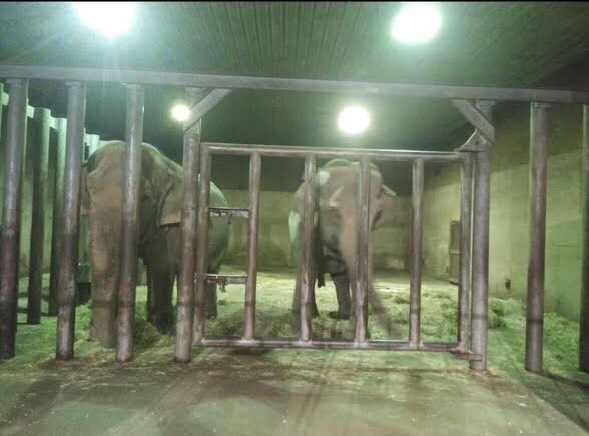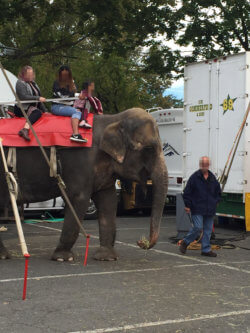Minnie the elephant remains in urgent need of sanctuary
UPDATE (8/18/21): The USDA included Beulah’s necropsy in its response to a January 2020 records request submitted by the NhRP. The necropsy revealed that at the time of her death, Beulah was suffering from pyometra and septicemia and had pleural adhesions, a coronary artery embolism, and a pulmonary artery embolism.
Last month, eighteen months after we submitted a Freedom of Information Act (FOIA) request to the USDA for records related to Beulah, Karen, and Minnie, we finally received the responsive records. The 303 pages of documents shed light on the USDA’s failure to protect our clients, the ineffectiveness and insufficiency of existing animal welfare laws, and the appalling details of the Commerford Zoo’s imprisonment and exploitation of Karen, Beulah, and Minnie.
Since Beulah and Karen’s deaths in 2019, we have obtained extensive records on the lives of all three elephants, with Minnie now the sole surviving elephant. Last year, with the assistance of Connecticut Senator Richard Blumenthal, we learned Karen died in March 2019 from kidney disease, and Beulah died of septicemia caused by a uterine infection while being exhibited at the Big E fair in Massachusetts.
The more recent records detail the extent of Karen and Beulah’s illnesses and reveal that the Commerford Zoo—for years longer than was previously known—continued to compel them to labor at fairs and other events across the northeast while knowing they were sick. A December 2019 intra-agency memo drafted by Jan Baltrush, the USDA inspector who has been the designated inspector for the Commerford Zoo since 1988, states that at the time of her death, Beulah had an approximate “10 [year] history of occasional blood and mucopurulent discharge in her urine. Uterine tumors were suspected.”
What this means is that, during the ten years Beulah suffered from suspected uterine tumors and related issues, the Commerford Zoo continued to force her into cramped trailers and transport her across the northeast for their financial gain. Likewise, Karen had been suffering from suspected kidney disease for the year prior to her death. Blood tests revealed that her creatine levels were high for an elephant: in December 2017 her creatine level was 2, in August 2018 it was 6, and at the time she passed away, it was as high as 9.4. When she died in March 2019, neither the USDA nor any agency with oversight authority required that a necropsy be performed. According to Baltrush’s memo, this was because the Commerford Zoo was “confident that this death was a result of kidney disease.” In other words, the USDA accepted the Commerford Zoo’s uninformed and unofficial cause of death, rather than requiring a standard necropsy.

The records include other grim examples of Beulah and Karen’s suffering. At Karen’s last known public sighting in July 2018 at the Meadowlands Fair in East Rutherford, NJ, she was seen swaying as she was forced to give rides to children and adults. Witnesses expressed concern over Karen’s appearance and behavior: her skin had sores and she was engaging in stereotypic behavior indicative of suffering. Likewise, Beulah was taken to countless fairs during the 10 years she had suspected uterine tumors and related health issues. In response to a complaint filed in 2016, in which a fairgoer at the Broom County Fair in New York reported they saw Beulah urinating blood, the USDA interviewed a representative of the Commerford Zoo who confirmed that several years prior Beulah was diagnosed with a medical condition that includes the passage of dark red to purple color mucoid. Nevertheless, the USDA continued to allow the zoo to transport Beulah to fairs where she was forced to work, up until her death.

The records also demonstrate the USDA’s skewed view of the proper treatment of elephants and the extreme deference they give to licensed exhibitors like the Commerford Zoo. Multiple times throughout the records, USDA inspector Baltrush claims Minnie is not experiencing physical or psychological harm. This is despite Minnie being housed, primarily, in a barren barn with concrete flooring and little natural light. She is also alone. It is well known that elephants are highly social animals who suffer greatly when deprived companionship of other elephants. Additionally, Minnie has frequently been observed engaging in stereotypic behavior such as swaying. It is unthinkable that an experienced inspector could think that forcing an elephant to live in solitary confinement is not causing any psychological harm. This highlights the USDA’s fundamental lack of understanding about elephants.
Lastly, the records reveal the bleak existence Minnie is currently leading. She lives alone, imprisoned in a small barn with barred stalls and concrete flooring. She allegedly is let outside daily, although the USDA has no proof of this other than the Commerford Zoo’s assertion that she is. She has not been seen in public for almost two years, and there have been no reported sightings of her over the past year while the Commerford Zoo has been opening its farm to the public. Last year, a GoFundMe fundraiser endorsed by the Commerford Zoo which sought to raise $2.4 million for them, stated that the zoo was impoverished and unable to afford Minnie’s food or veterinary care.
It’s clear the USDA failed Beulah and Karen and is continuing to allow Minnie to languish at the Commerford Zoo. Because of both the ineffectiveness and insufficiency of animal welfare laws and the USDA’s unwillingness to enforce existing laws and regulations, the agency is still failing Minnie. Such failures are all too much common and, sadly, not unexpected, which is exactly why we fight for elephants’ right to liberty.
Please use your voice to help Minnie and complete this action alert asking the Commerford Zoo owners to send her to a sanctuary where she can live freely and with peace and dignity. Additionally, if you’re on Facebook, you can comment on their new Facebook page and politely ask that she be sent to a sanctuary. For a full list of ways to help Minnie, click here.
The records linked below are over 300 pages. If you would like to read the key parts, please refer to this appendix:
Page 33: Description of elephant barn at the Commerford Zoo
Page 49-50: Detailed memo on Karen and Beulah’s illnesses and deaths
Page 58: An Animal Welfare Complaint submitted to the USDA from the Connecticut Department of Agriculture
Page 158: Procedure for when an animal dies and a USDA inspector is not present
Page 182-183: Details of Beulah death and description of barn at Commerford Zoo
Page 208: Letter from Tim Commerford
Page 212: USDA notified of Beulah’s death
Page 221-222: Results of Animal Welfare Complaint regarding Beulah urinating blood while being exhibited at a fair
[gview file=”https://www.nonhumanrights.org/content/uploads/2020-APHIS-01597-F-1_Redacted.pdf”]